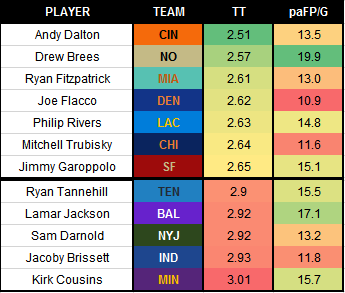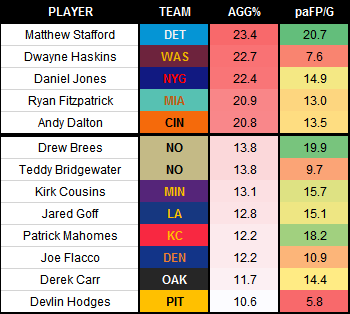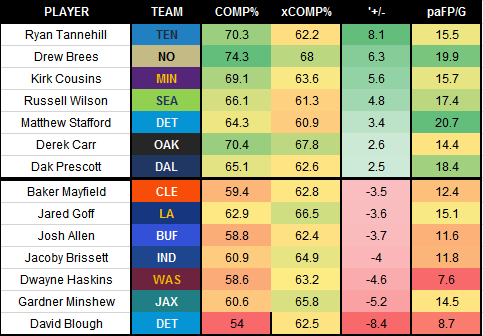Antonio Losada provides key fantasy football updates for quarterbacks, using Next Gen data to help fantasy owners make the best lineup and waiver wire decisions.
Time's up! The 2019 fantasy season is done and gone for good. Whether you play in a redraft league or are part of a dynasty format, the days of sitting at the edge of your couch and biting your nails are over. We have a tough eight-month desert to walk through ahead of us, but hey, the real NFL players are this close to kick-off and we will still enjoy football for another month and change, so you better get to it while it lasts! With the numbers in place and the games finished, it's time to wrap up the series and take a final look at who was who during this 2019 season.
To gain the biggest edge in your fantasy football league, it's necessary to understand how to apply the advanced statistics being used in sports nowadays. Back in the day, it was all about wins and losses, passing yards, and touchdowns scored. It's not that those stats are now worthless, they just don't offer enough information to savvy analysts. While football is still in its infancy compared to baseball in terms of analytics, the evolution the sport has seen lately in those terms is notable.
Each week, I'll be tackling NFL's Next Gen Stats, bringing you data from the just-completed week's games with notable takeaways you should consider when assessing fantasy players for the upcoming week. In case you're new to the series, or Next Gen Stats altogether, I recommend you read our preseason primer. Now, let's get to the data!
Be sure to check all of our fantasy football rankings for 2025:- 2025 fantasy football rankings (redraft)
- Dynasty fantasy football rankings
- 2025 NFL rookie fantasy football rankings
- Best ball fantasy football rankings
- Quarterback fantasy football rankings
- Running back fantasy football rankings
- Wide receiver fantasy football rankings
- Tight end fantasy football rankings
2019 Best and Worst Quarterbacks - Next Gen Stats
The season, at least for us fantasy nuts is finally over. That is nothing good for our enjoyment of the fantasy game, but it is a time of calm and peace to enjoy the real NFL playoffs that we're also invested in. With all of the regular season numbers now in place, it is time to wrap up the Next Gen Stats series position by position.
Today I will go through the quarterback position and provide a final update on how the league's passers have done in the different metrics we've already tackled during the season. I will only show a small number of names for each category, present its correlation with the fantasy points averaged by the player, the skip gory details, and instead provide a new "combined" leaderboard at the end of the column.
As we'll be discussing quarterbacks and their passing stats, I will reduce the fantasy points per game averages to just those related to passing. That means that I have removed the rushing/receiving fantasy points the qualifying quarterbacks have logged during the season (that is why Matthew Stafford has a better fantasy average than Lamar Jackson, for example). I've called this "new" metric paFP/G, which is to say passing Fantasy Points per Game. I have included the full fantasy points average (passing, receiving, and rushing stats included, labeled simply FP/G) for context. So let's dive in!
Note: The cutoff to qualify is set at 128 pass attempts.
Time to Throw
Correlation with Passing Fantasy Points: negative-10%
Leaders and Trailers:

Completed/Intended Air Yards / Air Yards Differential
Correlation with Passing Fantasy Points: 49% / 39% / 10%
Leaders and Trailers:

Aggressiveness
Correlation with Passing Fantasy Points: 4%
Leaders and Trailers:

Attempts / Yards / Y/A
Correlation with Fantasy Points: 55% / 67% / 65%
Leaders and Trailers:

Completion Percentage / xCOMP / COMP Above Expectation
Correlation with Fantasy Points: 49% / 9% / 53%
Leaders and Trailers:

Combined Next Gen Stats Leaderboard
To build this leaderboard I used every metric that is part of the NGS site and put everything together in a combined score I labeled "NGS" in the following table. The calculation of each player's NGS score is simple. I calculated where each player ranked for each metric and then multiplied that rank for the correlation between that metric and my paFP/G metric. Players ranked higher (closer to one) in each category will have lower scores for those categories. In the end, I added up each player's scores from all of the categories getting a single NGS score.
The lower the NGS, the better the player for fantasy as each category was already weighted given its correlation with the paFP/G metric. Here are the results:

NGS Leaderboard Notes:
- For the second time in the column and before you throw all of your anger toward the screen of your laptop, there is a reason Lamar Jackson ranks ninth in NGS: We're considering exclusively passing stats for quarterbacks here. That's why. Lamar Jackson has been a cheat code in fantasy football this season because he was an RB+QB packed into one single person. For the purposes of this leaderboard, though, that first chunk is not part of Lamar so he lost a ton of ground when compared to other players at the position.
- With Lamar's asterisk explained, it's time to drool over Dak Prescott's and Russell Wilson's seasons as they finished with virtually the same NGS score at the end of the year!
- Prescott finished the season ranking inside the top five in five of the 16 NGS categories, and he also finished third in paFP/G. Wilson ranked inside the top five in four of 16 categories while averaging the fifth-most paFP/G among qualified QBs.
- Prescott edged Wilson in CAY, but Wilson aimed for more IAY than Prescott. At the end of the day, though, Prescott finished the year throwing a higher volume of passes and thus having more yards and attempts (though he finished with fewer TDs and had a less efficient season than Wilson overall). That volume is what helped Prescott finish the season as the No. 1 "pure" passer in 2019.
- Despite throwing 30 (!) interceptions and being a real-life headache for Tampa Bay, Jameis Winston proved to be a fantasy darling this season once more. He finished third (still a ways behind Prescott and Wilson, though) in NGS score and same as Prescott he owed most of it to his high willingness to throw booming passes, having a huge volume of throws, racking up more yards than anyone (he's the only QB to break the 5K-mark this season) and finishing second in touchdowns with 33.
- Jacoby Brissett got some early-season love but he dropped the ball incredibly as the year progressed. He finished the season ranked 29th in paFP/G and 31st in NGS, the worst marks among QBs with more than 10 games played. He ranked inside the bottom-five in three of the NGS categories and his best position was 15th in xCOMP%, which sadly isn't that heavily factored and impactful in fantasy terms.
- Other disappointing QBs with at least eight games played were Devlin Hodges, Mason Rudolph, Dwayne Haskins, Joe Flacco, Teddy Bridgewater, and Case Keenum. All of them were reserves thrust into starting roles or starters sent to the bench during the season. No wonder why...
- Only two quarterbacks posted 20-plus paFP/G in Matthew Stafford and Drew Brees (virtually, don't kill me). They ranked 11th and 16th in NGS respectively, though, and their profiles in these Next Gen Stats were wildly different. Stafford ranked first in four categories, second in another one, and top-five in two more; his best numbers came in the "volume/willingness" categories such as CAY and IAY, AGG%, Y/A. Brees, though, ranked first in two categories, second in three, and top-5 in two more; his best numbers came in "efficiency" metrics such as COMP%, +/-COMP%, QBRate, and TT.
- Although Deshaun Watson didn't rank inside any metric top-five he still had the second-highest overall rank among all NGS categories with an 11.8 finish when taking everything into account. He could only finish fifth in NGS score after adding the correlation factors to the calculation, though, as his best numbers didn't come in the most fantasy-related metrics.
 RADIO
RADIO
























